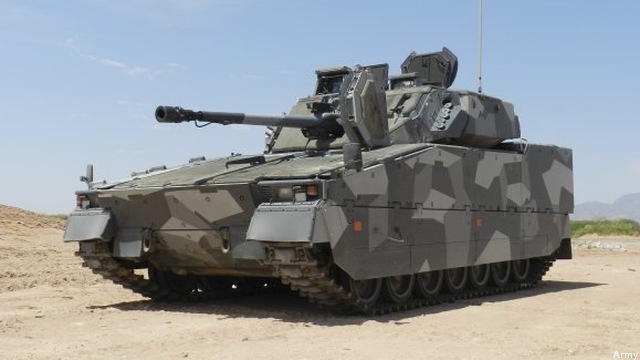
The Army’s senior leadership is determined to spend money on a new Ground Combat Vehicle (CV) to replace the aging Bradley Armored Fighting Vehicle. On the one hand, the admission that tracked mobile armored firepower is critical to survival and success in future combat is gratifying. On the other hand, the determination to focus on incremental improvements to a single piece of equipment in isolation from the warfighting requirements of the larger joint force is disappointing. Frankly, it makes no sense to replace Bradleys inside the existing Army force structure. Without a new Army force design in place, an Army design for Joint, integrated warfare against capable future adversaries with armies, air forces and air defenses, this Army program should be canceled and defunded. This is not the time to build a better carburetor. It’s time for fuel injection.
What Congress should compel the Army to perform is objective analysis and experimentation. Congress should demand the Army’s four stars capture the budget, schedule, performance, and structure base line. The Army must identify the costs and savings associated with current and future equipment, especially in the context of the current force design. Keep in mind “modularity” started out at $20 billion and eventually reached $48 billion. By the time the future combat system (FCS) was canceled, the American Taxpayer had already lost at least $20 billion.
Congress should recall that every Army Chief of Staff since 1991 has touted some big reform and modernization plan, yet next to nothing has changed. It’s no surprise that the Army’s top general have repeatedly declined to perform analysis and simulation with competing force design alternatives. In the final analysis, Modularity + FCS would have cost the taxpayer more than $200 billion and resulted in no net increase in fighting strength. Worse, these now defunct programs equipped only one-third of the Army in 20 years. What will the introduction of a Bradley replacement achieve? Will the new GCV dramatically increase the Army’s fighting power? Will it make Army forces more deployable? Will it provide a capability that magnifies the striking power of the Air Force, Navy or Marine Corps?
The answer is not much, if anything. It is time for the House and the Senate to demand real experimentation with multiple force design options for the Army, active and reserve. The right approach involves examining limited numbers of prototype organizations and equipment inside a new force design before billions of dollars in scarce investment funding are committed. In his book, The Innovator’s Dilemma, Clayton Christensen explains what should happen.
“Many of the ideas prevailing at Intel about where the disruptive microprocessor could be used were wrong; fortunately, Intel had not expended all of its resources implementing wrong-headed marketing plans while the right market direction was still unknowable. As a company, Intel survived many false starts in its search for the major market for microprocessors.”
The point is simple: a qualitative increase in fighting power begins when the force employs new technology and develops the concepts and organizations to exploit new, emerging capabilities. Without the pressure to change its direction, the institutional Army leadership will create some future combination of the French experience in 1940, Task Force Smith in Korea in 1950 and Task Force Ranger in Somalia in 1993.
For today’s Army senior leaders who are still wedded to a Cold War institutional status quo they grew up with, the French interwar experience explained in Julian Jackson’s book, The Fall of France, is instructive: “In 1934, military spending had accounted for one-fifth of all government expenditure; by 1938 it accounted for over one-third… In the end, the changes which had occurred (in the French Army) were basically incremental adjustments, albeit important ones, of a corpus of doctrine that had not fundamentally changed.”
Instead of asking hard questions, instead of listening to men like Charles de Gaulle, a colonel marginalized for his advocacy for fundamental change in the design and content of French Forces, French politicians invested heavily in the WW I French Army until it was defeated in 1940. But the French were not alone in their folly.
In his book, Fast Tanks and Heavy Bombers, David Johnson (who just took over Army CHief of Staff Odierno’s Strategic Studies Group) asks why nothing remotely like “Blitzkrieg” tactics and innovations emerged inside the U.S. Army. What Johnson discovered is worth remembering. A combination of factors ensured the Army was the wrong force for war in 1942. Of these, the most significant was not a lack of funding. First, there was almost total ignorance in Congress about what was really happening inside the Army. And, second, it was the intellectual — not the fiscal — deficit that obstructed useful change in the Army. As for those who argued after World War II that if the Army had been better resourced a different army would have emerged, Johnson discovered it was not true. Had more money been available, Johnson concluded, the Army’s generals would have simply done more of the same. The American people don’t need more of the same and the American Taxpayer cannot afford to repeat the mistakes of the past. Military institutions, grounded as they are in the past, are not particularly adept at dealing with the future. This is especially true for the Army. Congress can and must ask the tough questions and demand real answers, not platitudes before increasingly scarce funds are lost on yet another wrongheaded Army program, yet another false start.
France, Germany ink deal on way ahead for ‘completely new’ future European tank
Defense ministers from both countries hailed progress on industrial workshare for a project that they say “will be a real technological breakthrough in ground combat systems.”


























